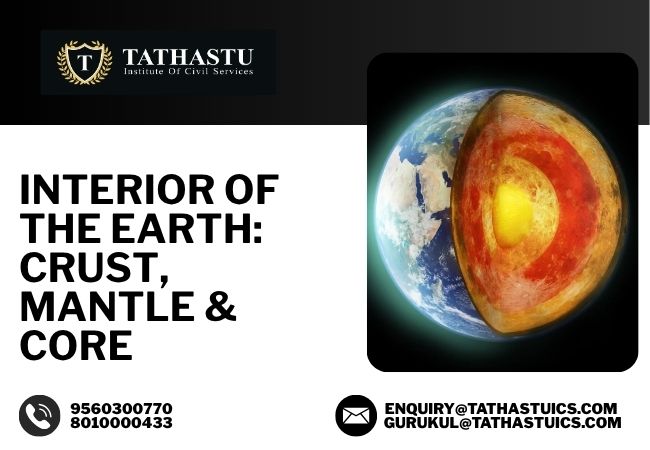Our planet conceals an immeasurable number of mysteries that exist beneath its surface. We walk on top of solid rock but below us exists a continuously shifting deep interior that harbors great pressure with vast heat. All planet levels from the surface crust through the entire scope of the core element together define our familiar world. The geological history of Earth manifests through its crustal rock minerals, yet continuous rock cycle processes continue shaping the Earth to this day.
Interior of the Earth
The Earth consists of three distinct layers, which are presented successively by crust then mantle and lastly core.
The Crust
- The Earth’s crust serves as its outermost layer because it is also its thinnest one, spreading from 5 km oceanic to 35 km continental mass thickness.
- The continental crust primarily consists of silica as well as alumina which justifies its scientific name “sial” (si-silica + al-alumina).
- In comparison to oceanic crust, the oceanic crust consists of silica combined with magnesium referred to as sima (si-silica, ma-magnesium).
- Although the crust remains the Earth’s thinnest layer, it displays the greatest diversity, where all surface life on Earth depends on it.
The Mantle
- Moving below the crust extends the mantle until it reaches depths of 2,900 km.
- This layer represents the Earth’s largest region with its slow-moving semi-solid rock nature.
- Tectonic plate movements originate in the mantle because this layer leads to Earth’s surface transformation through earthquake activity and volcanic eruptions.
The Core
- The deepest layer of Earth features the core extending at a radius of 3,500 km.
- The rock contains high amounts of nickel together with iron thus earning its name nife from the combination of ni-nickel and fe-ferrous.
- The core is divided into:
- the outer core (molten state), and
- the inner core (solid state due to immense pressure).
- The extreme temperature and pressure of the core drive the Earth’s magnetic field.
Rocks and Minerals
Natural masses of mineral matter compose the Earth’s crust into different types of rocks. Rocks exist in three fundamental categories depending on their development process.
Igneous Rocks
- Igneous rocks, known as primary rocks, develop after molten magma cools down for solidification to become igneous.
- The slow underground cooling of magma into rock creates intrusive igneous formations, i.e. granite.
- Extrusive igneous rocks emerge as basalt through lava cooling that produces fine-grained structures when occurring rapidly on exposed surfaces, i.e. the Deccan Plateau in India (basalt rock formations)
Sedimentary Rocks
- Sedimentary rocks develop through the natural drift and subsequent compression of sand, silt and organic materials over generations.
- Sandstone makes up one type because it comes from compacted sand grains, while limestone originates from calcium carbonate materials.
- Fossils preserved within sedimentary rocks help scientists gain an understanding of the Earth’s historical events.
Metamorphic Rocks
- Measurements of high temperature and pressure acting upon both sedimentary and igneous rocks result in their transformation into metamorphic rocks.
- The transformation of clay results in slate, whereas limestone transforms into marble.
- The Taj Mahal emerges as a worldwide famous monument constructed entirely from white marble.
The Rock Cycle
Rocks show no stability because they participate in a perpetual rock cycle process. It works:
- Rocks autogenerated through cooling magma become igneous rocks.
- Rocks eventually erode into sediments that, after compaction, become sedimentary rocks.
- Heat and pressure cause both igneous and sedimentary rocks to transform into new metamorphic rocks.
- Under intense circumstances, metamorphic rocks will eventually melt into magma to start the rock cycle anew.
Importance of Rocks and Minerals
Human life requires both rocks and minerals to exist. They are used in:
- Construction activities use granite and marble rocks alongside others for creating houses and roads, and monuments.
- Manufacturing alongside technology heavily depends on three fundamental minerals which include iron, aluminum and gold.
- The power sector requires natural gas, together with coal and petroleum minerals, as primary energy components.
- The pharmaceutical sector makes use of minerals, while agriculture depends on minerals to produce fertilizers and multiple industrial products.
Conclusion
The Earth’s main structure, along with its upper crust, demonstrates the continuous transformations that occur within our planet. The Earth’s geological richness emerges from its three-layered structure and various mineral compositions as well as different types of rocks. Understanding geological processes enables us to satisfy our scientific interest and it makes clear the significance of conservation efforts that protect resources for future times.

